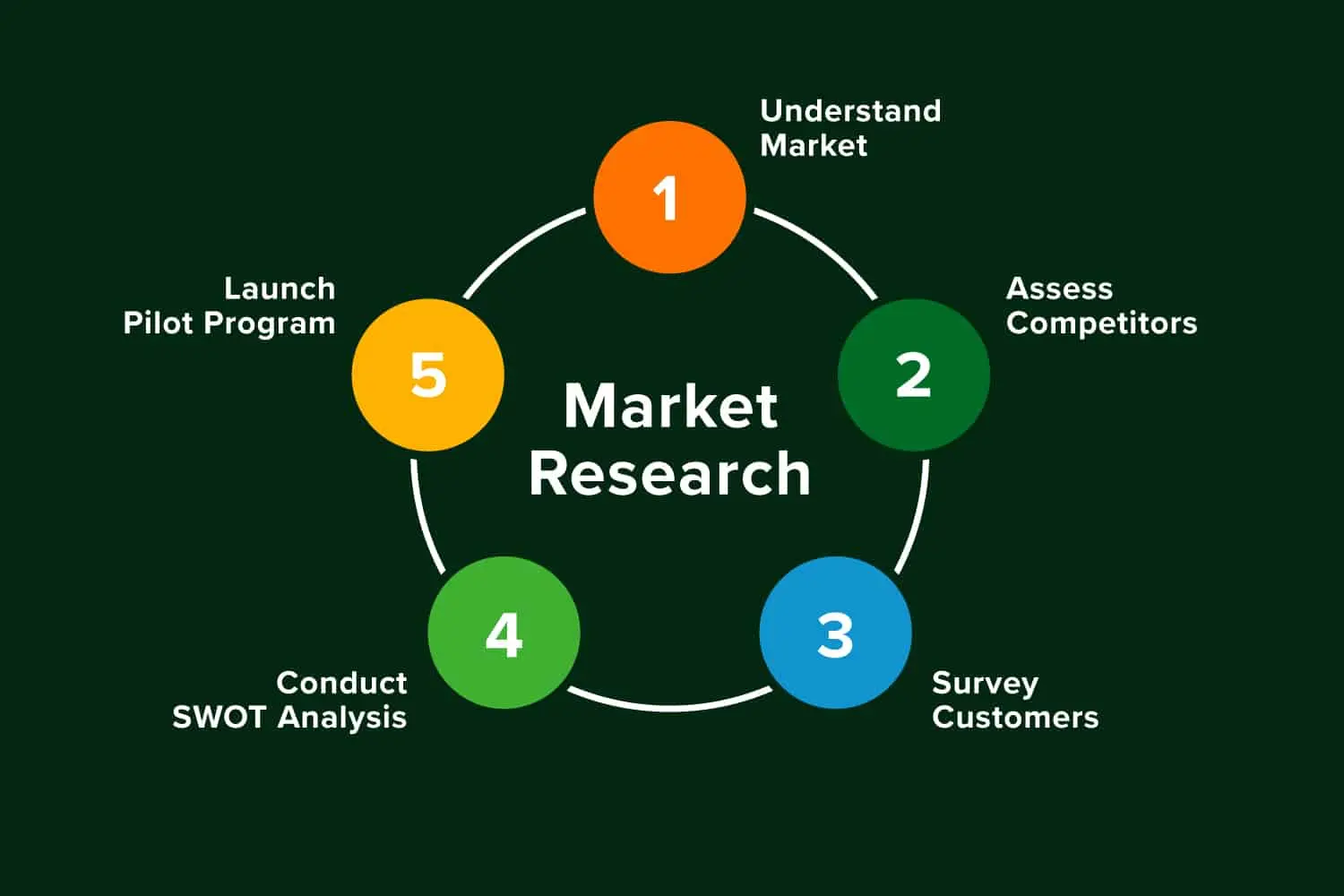Disclaimer: The articles published here on the City of Eau Claire Economic Development Division website are meant to be a helpful starting point as you explore doing business in our community. They’re not the final word on rules, requirements, or what’s best for your unique situation. We always recommend checking in with legal, financial, or other professionals for advice tailored to your business.
Starting a business can feel overwhelming. Maybe you want to open a storefront, introduce a new product, or bring a fresh service to town.
No matter your path, one of the smartest steps you can take at the beginning of your entrepreneurial journey is diving into market research. Taking the time to really understand the Eau Claire, Wisconsin community before you open your doors can help you spot opportunities, avoid costly missteps, and set your business up for long-term success.
To help get you started, this guide breaks down how to approach market research in a way that’s grounded in the needs and unique character of our local economy.
Step #1: Understand the Eau Claire Market & Demographics
Before jumping into surveys or scoping out your competition, it’s a good idea to get a feel for the people within the Eau Claire community. Understanding who lives here and what they care about will help make sure your business is a natural fit for our market.
Age Groups
Eau Claire is a young, vibrant city, thanks in large part to our two universities. That means you’ll find a lot of students (18–24) looking for affordable places to eat, hang out, and live. Then there’s the young professional crowd (25–35), who tend to value sustainability, work-life balance, and healthy living. Families (35–50) are usually focused on value, especially when it comes to anything that benefits their kids, homes, or education. And don’t forget retirees and empty nesters (50+), who are drawn to Eau Claire’s laid-back vibe, outdoor amenities, and affordable living. They often spend more on wellness, leisure, and home improvement.
Income Levels
The average household in Eau Claire brings in about $60,000 a year, but that number can swing quite a bit depending on where you are in the city. Downtown Eau Claire, with its newer developments, tends to have more residents with disposable income, while outlying neighborhoods may be more budget-conscious. Knowing where your target customers live and what they’re likely to spend helps you fine-tune your pricing and offerings.
Education & Workforce
Eau Claire is also full of well-educated people. That gives us a skilled workforce, particularly in areas such as healthcare, tech, and the arts. But there are still gaps, especially in skilled trades and technical fields, which could create opportunities for businesses focused on training or workforce development.
Lifestyle & Spending Habits
People in Eau Claire love the outdoors and care deeply about sustainability. Products and services that support healthy lifestyles, eco-conscious living, or outdoor fun are likely to resonate here, especially with younger residents. Also, more and more people are shopping online, so businesses that offer flexible or hybrid models (like local delivery, e-commerce, or curbside pickup) can expand their reach and meet people where they are.
Step #2: Assess Your Competitors
Once you’ve got a handle on who lives in Eau Claire and what they value, the next step is figuring out who else is already doing what you want to do and how you can stand out. Diving into the competitive landscape will help you see what’s working, what’s missing, and how your business can fill a gap.
Start by identifying who your competitors are. A quick Google search, a scroll through social media, or checking out review sites like Yelp can give you a good snapshot. Look for both direct competitors, ones offering the same or very similar products or services, and indirect competitors, ones that may not sell the same thing but still attract your ideal customers. For example, if you’re planning to open a bakery, your direct competition might be another local bakery, while your indirect competition could include cafés or even grocery store bakeries. Don’t forget to think beyond Eau Claire too—businesses in nearby communities Altoona and Chippewa Falls will also be competing for your customers since they’re just a short drive away.
Once you’ve got your list, dig a little deeper. What are your competitors offering? How’s the quality? What are their prices like? Try to figure out what they’re doing well and where there might be room for you to do things differently or better. Ask yourself: “What’s my unique edge? And how can I bring something new or improved to the table?”
You’ll also want to look at how they’re marketing themselves. What platforms are they using—Instagram, Facebook, email newsletters, paid ads? What kind of content do they share, and does it seem to resonate with their audience? Are they offering promotions or loyalty programs to keep customers coming back? The more you know about how they connect with people, the easier it’ll be to carve out your own niche. Customer reviews can be goldmines too. Read what people love and what they complain about. This can help you spot areas where your business could shine by solving a problem your competitors aren’t addressing.
And if you can find any financial data, such as revenue, growth trends, or even hints from press releases, it’s worth a look. Knowing whether your competitors are thriving, struggling, or just holding steady can give you insight into what to expect and how to position yourself for long-term success.
At the end of the day, understanding your competition isn’t about copying them; it’s about learning from what’s out there so you can build something even better.
Step #3: Survey Potential Customers
Talking to your potential customers might sound like a no-brainer, but many entrepreneurs don’t do enough of this before opening their new business’s doors, and it’s one of the most powerful tools you have. No matter what you intend to sell, customer feedback can help you validate your ideas and fine-tune your offerings before you invest too much time or money.
Start with online surveys. Tools such as Google Forms or SurveyMonkey make it easy (and free!) to reach a wide range of people. Share the survey on your social media channels, in local Facebook groups, or through your personal and professional networks. Ask questions about buying habits, price sensitivity, and preferences related to your specific industry. And if you already have a few product ideas or service models in mind, let people rank them or give open-ended feedback. You’d be surprised how quickly patterns start to emerge.
Next, go offline. Eau Claire is a relationship-driven community, so face-to-face conversations can go a long way. Grab a clipboard and head to high-traffic spots like the parks or community event (with the organizer’s permission). Approach folks with a smile and a short pitch: “Hey, I’m starting a [type of business] in Eau Claire and would love your opinion. Do you have two minutes to answer a few quick questions?” Keep it casual, and remember, you’re not selling yet—just listening.
If you want more in-depth insights, try hosting a small focus group. You can rent a room at the library, a co-working space like The Coven or BONDS CoWork + Social Club, or even gather folks at a local café with the promise of coffee and snacks. Choose participants who reflect your ideal customer—age, lifestyle, income level, and so on. Then, lead a relaxed but structured conversation about their needs, frustrations with current options, and what would make them try something new. These discussions often spark ideas and uncover details you hadn’t considered.
The bottom line is, the better you understand your future customers, the better equipped you’ll be to serve them right from the start.
Step #4: Conduct a SWOT Analysis
Now that you’ve collected some solid insights, it’s time to put it all together in a SWOT analysis. This simple framework helps you see your business idea through a strategic lens by breaking things down into four key areas: Strengths, Weaknesses, Opportunities, and Threats.
Start with your Strengths. What gives your business an edge? Maybe you have specialized experience, a unique product idea, or a strong local network. Maybe there’s no one else in Eau Claire doing exactly what you’re planning. Write it all down: these are your advantages, and you’ll want to leverage them in your marketing and operations.
Then, be honest about your Weaknesses. Are there skills you still need to develop? Are you limited by funding, time, or staff? Maybe you’re brand new to entrepreneurship, or you’re trying to break into a saturated market. Identifying your weaknesses upfront allows you to plan around them and seek support when needed.
Next, look outward for Opportunities. What’s happening in Eau Claire, or even nationwide, that you can tap into? Maybe there’s growing demand for eco-friendly products, or the city’s new developments are attracting more foot traffic to a new district. Maybe you’ve noticed more people working remotely and looking for flexible childcare options, pet services, or daytime meet-up spaces. Trends like these can create a prime opening for your business to thrive.
Finally, consider the Threats. These could include new competitors, economic downturns, supply chain challenges, or changes in local regulations. Don’t let this part scare you… It’s not about being discouraged; it’s about being prepared. When you know what could go wrong, you’re better positioned to pivot and adapt.
When it’s finished, your SWOT doesn’t have to be a formal report. It can be a simple bullet list on paper or a whiteboard brainstorm. The point is to get a clearer view of your business’s potential, both in terms of promise and pitfalls.
Step #5: Test the Market with a Pilot Program
When you’re ready to get your new business off the ground, you don’t have to launch big right away. In fact, some of the most successful businesses in Eau Claire started small—testing their concept with a pilot program or soft launch before going all-in.
This could mean hosting a pop-up shop, setting up a booth at at a local event, or partnering with another business to share space for a weekend. If you’re offering a service, maybe you provide it for free or at a discounted rate to a small group in exchange for honest feedback. You could even run a limited-time online offer to test interest and see what kind of traction you get.
The idea here is to gather real-world feedback without the pressure of a full-scale launch. It’s like a dress rehearsal for your business—one where you can identify issues, make improvements, and gain early supporters who can help spread the word when you’re ready to launch officially.
Eau Claire has tons of opportunities for this kind of testing. By piloting your business in the real world, you’ll learn more in a few weeks than you could with months of planning.
Conclusion
Market research a powerful tool that sets the foundation for a successful business. And here in Eau Claire, taking the time to understand our unique community can be the key to standing out and making a lasting impact. By diving into local demographics, studying the competition, listening to your future customers, and testing your ideas in real time, you’ll be better prepared to build something that truly resonates with the locals.

About The Author
Kendall Williams
City of Eau Claire Economic Development Division
Kendall’s role is to champion local businesses at every stage of their journey. Whether it’s helping new entrepreneurs find the right location, supporting existing businesses as they grow, managing the City’s loan programs, or providing data to guide smart decisions, she’s all about making Eau Claire a place where businesses can thrive.




